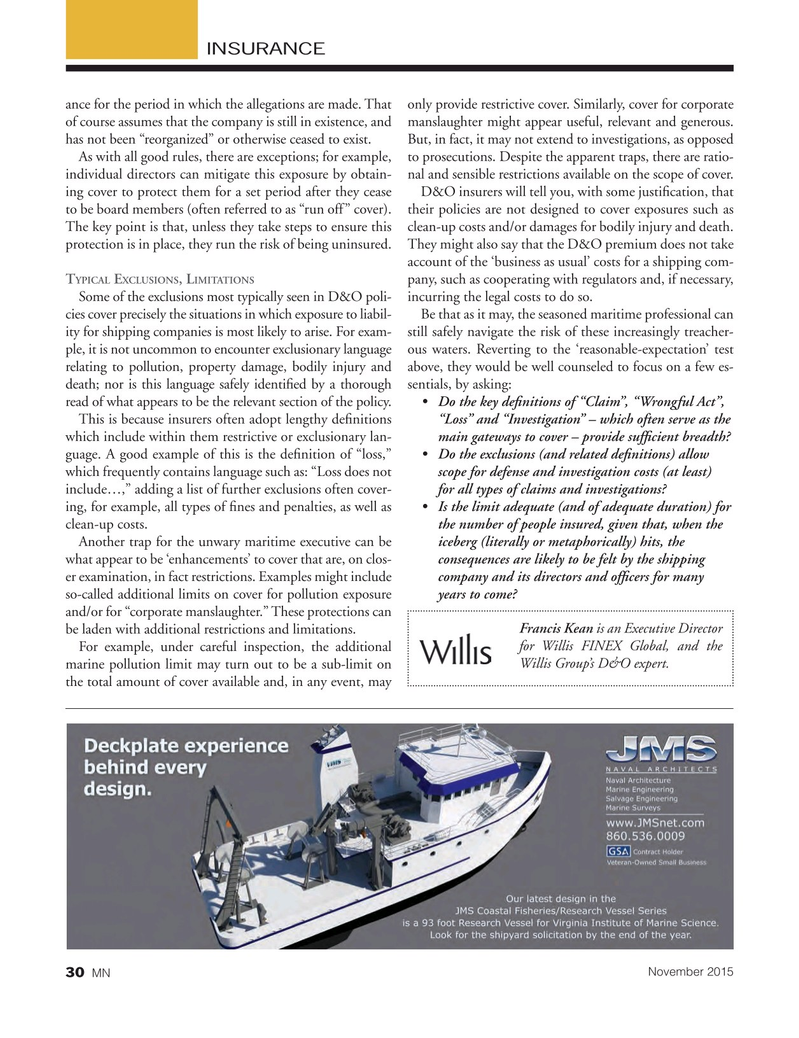
Page 30: of Marine News Magazine (November 2015)
Workboat Annual
Read this page in Pdf, Flash or Html5 edition of November 2015 Marine News Magazine
INSURANCE ance for the period in which the allegations are made. That only provide restrictive cover. Similarly, cover for corporate of course assumes that the company is still in existence, and manslaughter might appear useful, relevant and generous. has not been “reorganized” or otherwise ceased to exist. But, in fact, it may not extend to investigations, as opposed
As with all good rules, there are exceptions; for example, to prosecutions. Despite the apparent traps, there are ratio- individual directors can mitigate this exposure by obtain- nal and sensible restrictions available on the scope of cover.
ing cover to protect them for a set period after they cease D&O insurers will tell you, with some justi? cation, that to be board members (often referred to as “run off” cover). their policies are not designed to cover exposures such as
The key point is that, unless they take steps to ensure this clean-up costs and/or damages for bodily injury and death. protection is in place, they run the risk of being uninsured. They might also say that the D&O premium does not take account of the ‘business as usual’ costs for a shipping com-
YPICAL XCLUSIONS IMITATIONS
T E , L pany, such as cooperating with regulators and, if necessary,
Some of the exclusions most typically seen in D&O poli- incurring the legal costs to do so.
cies cover precisely the situations in which exposure to liabil- Be that as it may, the seasoned maritime professional can ity for shipping companies is most likely to arise. For exam- still safely navigate the risk of these increasingly treacher- ple, it is not uncommon to encounter exclusionary language ous waters. Reverting to the ‘reasonable-expectation’ test relating to pollution, property damage, bodily injury and above, they would be well counseled to focus on a few es- death; nor is this language safely identi? ed by a thorough sentials, by asking: read of what appears to be the relevant section of the policy. • Do the key de? nitions of “Claim”, “Wrongful Act”,
This is because insurers often adopt lengthy de? nitions “Loss” and “Investigation” – which often serve as the which include within them restrictive or exclusionary lan- main gateways to cover – provide suf? cient breadth?
guage. A good example of this is the de? nition of “loss,” • Do the exclusions (and related de? nitions) allow which frequently contains language such as: “Loss does not scope for defense and investigation costs (at least) include…,” adding a list of further exclusions often cover- for all types of claims and investigations? ing, for example, all types of ? nes and penalties, as well as • Is the limit adequate (and of adequate duration) for clean-up costs. the number of people insured, given that, when the
Another trap for the unwary maritime executive can be iceberg (literally or metaphorically) hits, the what appear to be ‘enhancements’ to cover that are, on clos- consequences are likely to be felt by the shipping er examination, in fact restrictions. Examples might include company and its directors and of? cers for many so-called additional limits on cover for pollution exposure years to come?
and/or for “corporate manslaughter.” These protections can be laden with additional restrictions and limitations. Francis Kean is an Executive Director
For example, under careful inspection, the additional for Willis FINEX Global, and the marine pollution limit may turn out to be a sub-limit on Willis Group’s D&O expert.
the total amount of cover available and, in any event, may
November 2015
MN 30
MN Nov15 Layout 18-31.indd 30 10/23/2015 2:08:58 PM

 29
29

 31
31
